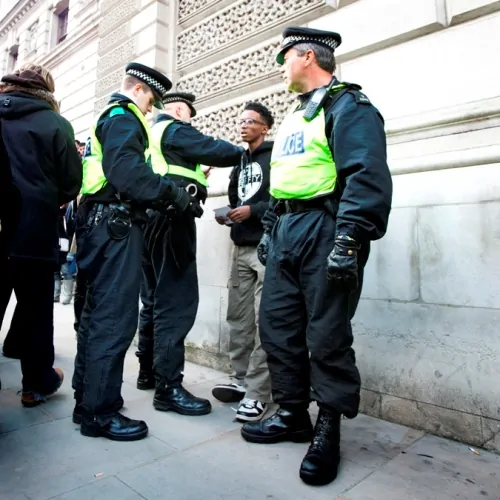Over the final weekend of March 2019 as the clocks went forward to mark the beginning of British Summertime, the UK Government seemingly missed the memo as they took us a step back in time, announcing the expansion of regressive police stop and search powers that hark back to the ‘sus’ era.
On 31st March 2019, the Home Secretary, Sajid Javid, unveiled the Conservative Government’s plan to make it easier for police forces in seven locations across the UK (including London, the West Midlands and Greater Manchester) to obtain authorisation to make stops and searches under section 60 Criminal Justice and Public Order Act 1994 citing the need to end Britain’s current knife crime epidemic as justification.
Legal commentators and social justice campaigners immediately criticised the Governments’ decision, expressing their concern that it was an unfounded knee-jerk reaction which would achieve nothing but an increase in discriminatory policing and further alienation of BAME communities whilst simultaneously disregarding the underlying causes of knife crime.
What does section 60 stop and search mean?
Stop and search under section 60 allows police to stop and search any person in a designated area without the need to establish that they have ‘reasonable suspicion’ for stopping that person. The exercise of this power can now be authorised by a more junior officer, namely an officer of or above the rank of Inspector (previously Superintendent), who believes that serious violence may (previously “will”) take place in the designated area and that the exercise of stop and search could prevent said violence by recovering weapons from suspects.
Why is the requirement of reasonable suspicion so important?
Prior to the enactment of PACE 1984 and the various safeguards it implemented, police had the power to stop and search members of the public under section 4 of the Vagrancy Act 1824. This power was commonly known as ‘sus’.
‘Sus’ allowed the police to stop, search and arrest anyone they suspected may commit a listed criminal offence. There was no need to establish reasonable suspicion.
‘Sus’ swiftly became a blunt tool of the criminal justice system, employed against BAME communities in gross disproportion. It’s excessive and discriminatory use was ultimately a large contributing factor to the ‘race riots’ which spread across the UK during the 1980s.
Thankfully, ‘sus’ was repealed in 1981. PACE was enacted shortly thereafter, and it codified the requirement for reasonable suspicion in what would come to be the most commonly used stop and search power under section 1 PACE.
The requirement of reasonable suspicion is a two-part test. Taking a scenario in which an officer is seeking to search someone for a prohibited article such as a knife, they must firstly establish that they have a genuine suspicion that that person is in possession of a knife, and secondly, that suspicion must be reasonable. Code A PACE outlines that reasonable suspicion must be “objective…based on facts, information and/or intelligence” and importantly, “cannot be based on generalisations or stereotypical images of certain groups or categories of people as more likely to be involved in criminal activity.” It is a crucial safeguard to ensure the appropriate use of stop and search.
The authorisation from the Government, therefore, to make it easier for the police to use an iteration of stop and search that not only fails to afford citizens the vital safeguards outlined above but also only requires the mere possibility that violent crime may be perpetrated is deeply concerning.
It threatens to erode the already fractured relationships between the public and the state, fuelling mistrust and fear.
Theresa May’s stop and search reforms
During her tenure as Home Secretary, now Prime Minister Theresa May championed the reform of stop and search in a powerful speech to the House of Commons in which she declared “nobody wins when stop and search is misapplied. It is a waste of police time. It is unfair, especially to young, black men. It is bad for public confidence in the police“.
As part of her reforms, Theresa May upped the threshold to obtain authorisation to exercise section 60, adding the requirement of ‘necessity’ and amending the senior officers’ suspicion that serious violent crime “will” take place.
In stark contrast to Theresa May’s comments in 2014, current Home Secretary, Sajid Javid justified the Government’s decision stating that stop and search is “hugely effective power when it comes to disrupting crime, taking weapons off our streets and keeping us safe”.
Is stop and search an effective police power or not?
In the year-end March 2018, just 8% of all searches made under section 60 in England and Wales resulted in an arrest. In contrast, the percentage of arrests resulting from searches made under section 1 PACE was 17%.
The statistics further reveal that not only is section 60 considerably less effective, it is also far more racially disproportionate. In 2018 38% of all searches under section 60 in England and Wales were of people who self-defined as black versus 19% of all searches under section 1 PACE, with Home Office statistics recently revealing that black people are 40 times more likely to be stopped and searched under section 60 than white people. For reference, black ethnic groups made up just 3.3% of the total population of England and Wales at the last Census in 2011.
The Home Office sought to justify the racial disparity by stating “low numbers of searches under section 60 mean inferring figures of racial disparities from this small subsection would be misleading.” However, Deputy Commissioner of London Metropolitan Police, Sir Steve House, revealed to the London Assembly Police and Crime Committee just yesterday that searches under section 60 in London had increased from 1,836 in the year 2017/2018 to a staggering 9,599 in 2018/2019.
Why has Government chosen to expand this power?
In 2019 it has become strikingly apparent that our Government simply do not know how to effectively tackle organised crime. From ‘knife ASBO’s’ for twelve-year-olds to facial recognition that gets it wrong 96% of the time, it’s obvious that the Government are focussing their attention on ill-considered reactive measures rather than protective policies that address the causes of violent crime. And the reason for this is simple. The Government have to be seen to be doing something to address knife crime and they need to be seen to be doing it now. Re-investment into communities, education and mental health services takes time and it costs money. Authorising section 60 is swift and costs nothing.
Social justice campaigners can only hope that the Government continue their recent trend of reviewing their previous decisions, and review their reliance upon ineffective and racially biased quick fixes before the most vulnerable members of our communities become further estranged from society at large.

